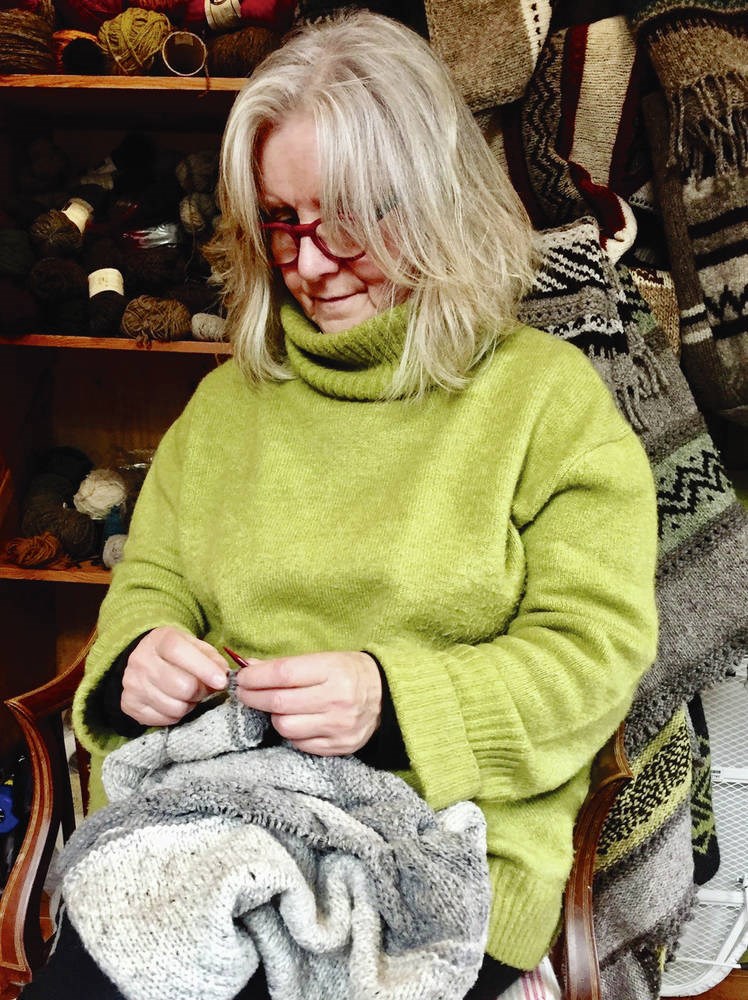North Saanich author Sylvia Olsen went on tour in support of her last book, Knitting Stories: Personal Essays and Nine Coast Salish-inspired Knitting Patterns, without knowing she’d have the framework for another book by the time she got home.
“There was was no thought of a [new] book when I was on that road trip,” she said of the 2015 trek, which included 40 knitting destinations and 52 scheduled classes for upwards of 900 participants, all hosted by Olsen.
“It was a book-launch trip around B.C. That’s what it started out as.”
What it became was the genesis for Unravelling Canada: A Knitting Odyssey, which arrived April 17.
Olsen, 66, has released two books in the past month, the 19th and 20th of her 20-year career — months after recovering from COVID-19. Growing Up Elizabeth May: The Making of an Activist, was co-authored with May’s daughter, Cate May Burton, and is aimed at young change-makers. Unravelling Canada: A Knitting Odyssey — which currently sits at No. 8 on the B.C. Bestsellers list — is about Canadian identity. The common thread in both — and every book by Olsen — is storytelling.
“Storytelling is my method of communicating. Writing was an extension of that.”
Her first book, about Kuper Island Residential School, was published in 2001. She taught herself how to write, thinking she would regret not giving a home to the stories she would frequently hear from elders in her extended family. Olsen was taken in by the Tsartlip First Nation, one of four Saanich tribes situated on the Saanich Peninsula, and shown their customs, including knitting.
Her son, Green Party MLA Adam Olsen, is a Tsartlip member, as are her two daughters and several grandchildren. Olsen, who is white, married into the community; her first husband, Carl Olsen, was born and raised in Tsartlip First Nation.
She spent nearly four decades there before relocating to North Saanich, where she now lives with her second husband, Tex McLeod.
She chooses to keep stories about knitting and First Nations culture alive through her writing. From kids’ picture books and young adult fare to historical research, Olsen continues to search for the true meaning of Canada. “The book takes on whichever form it needs to carry the story. It’s not finding a story to fit a form, it’s finding a form to fit a story. It’s why I’ve written so many genres, and probably never got really good at any of them.”
Olsen spent years in Tsartlip First Nation buying and selling Cowichan sweaters on behalf of the knitters, which made her uniquely qualified to write about knitting, specifically the Coast Salish practice (her master’s thesis at the University of Victoria in 1998 was about the history of Coast Salish wool working.) She also served as the bridge between her late ex-mother-in-law, Laura Olsen, who was Tsartlip First Nation, and her own daughters — one of whom, Joni, has become an expert knitter, and owns the Salish Fusion Knitwear brand.
Olsen is working with Joni on reopening a Salish Fusion Knitwear store in Tsartlip First Nation that would sell commercial products and house a museum with a dozen or so of Olsen’s most important sweaters on display, including one from 1931.
“I’m interested in how these sweaters relate to other sweaters, and how the sweater traditions and knitting traditions have morphed.”
Olsen and McLeod were making up the itinerary as they went from province to province during the 2015 book tour, responding to requests for classes along the way. They spent six weeks on the road, telling stories, listening to stories, and getting a better sense of what it means to be Canadian. Knitting was the hook upon which the day’s events were hung, but it soon became evident that Unravelling Canada would cover many bases.
Olsen discovered NONIA, a 101-year-old knitwear company in Newfoundland, whose knitters who were not hand-making items to support their families or for the life of their community, like Coast Salish knitters.
NONIA was founded to assist 1,300 coastal communities access basic health care. “That is a really important part of their story.”
These and other layers of Canada’s knitting history were top of mind throughout the trip, Olsen said. “If I’m going to go across Canada, I wanted to know what knitters said about Canada, and what Canada said about knitters. As a blonde, blue-eyed woman living in a First Nation, my relationship with Canada was very ambivalent. Looking out my kitchen window, my country did not look that great.”
Olsen, who teaches First Nations housing management at Vancouver Island University, said her journey to Sioux Lookout, Ontario, was another eye-opening experience. Sioux Lookout is where expectant mothers from remote northern First Nations are sent, often alone, to deliver their babies. Much is needed in the way of newborn clothing as a result, which prompted a woman named Peggy Sanders, who died in 2017, to knit thousands of hats for newborns over the years.
A group named the Northern Knitters has since taken up her cause and kept the tradition alive, to the tune of 500 hats for newborns annually. Olsen believes stories like that are what define Canadian character — hers included.
“The heart of the story was knitting, but knitting was the vehicle to take me though the country to find out more about myself.”



